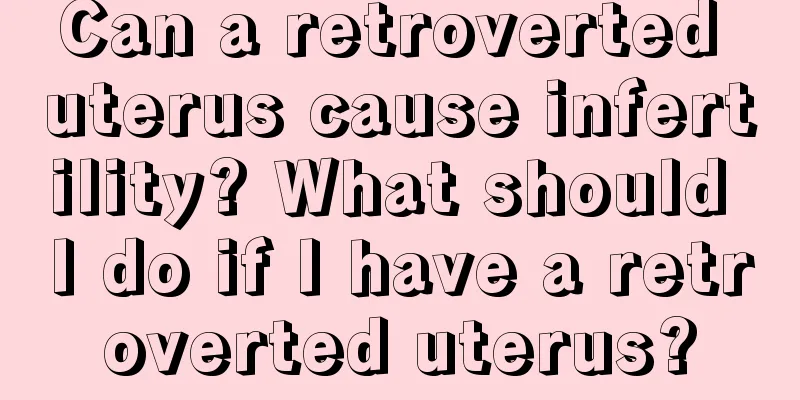Can a retroverted uterus cause infertility? What should I do if I have a retroverted uterus?

|
According to statistics, one in five women has a retroverted uterus. If you experience lower abdominal pain, menstrual pain, back pain, or even severe pain that makes you unable to straighten your back, you must find out the cause of the retroverted uterus and treat it to improve the condition. So, can a retroverted uterus lead to infertility? What should I do if I have a retroverted uterus and am infertility? What is a retroverted uterus?The uterus is a pear-shaped hollow organ with a muscle layer. The upper 2/3 is called the uterine body, and the lower 1/3 is called the cervix. The uterus is fixed in the pelvic cavity by many ligaments, so that in most cases, when a woman stands, the uterus will be horizontally attached to the bladder, which will show the natural state of anteversion of the uterus. 80% of women have an anteversion of the uterus; but when the long axis of the uterus is pointing to the back of the body compared to the angle of the vagina, it is called retroversion of the uterus. Dr. Lin Kezhen, director of Lin Kezhen Obstetrics and Gynecology Clinic, said that the uterus can generally be divided into anteversion, retroversion, anteflexion, and retroflexion according to its relative position in the pelvic cavity and the cervix. However, many people now easily confuse these two situations. The so-called tilt refers to the comparison of the axis between the uterus as a whole and the upper part of the vagina. If the uterus moves forward, it is anteversion, and if it moves backward, it is retroversion. The so-called flexion refers to the angle of curvature between the long axis of the uterus and the cervix. Once the uterus bends forward and the cervix remains in place, it is anteflexion; on the contrary, if the long axis of the uterus bends backward, it is called retroflexion. The uterus is fixed in the pelvic cavity by three major ligament systems: the round ligament, which pulls the uterus forward and maintains forward tilt; the uterosacral ligament, which pulls the cervix back toward the sacrum; and the broad ligament and cardinal ligament, the former covering the entire uterus and the latter being the transverse ligament. These ligaments allow the uterus to move freely up and down, left and right, but still maintain its position without shifting. The incidence of retroverted uterus is quite high, about 20%. Dr. Lin Kezhen said that according to estimates, 1 in 5 women has retroverted uterus, but many people have no symptoms or feelings. The causes of uterine incontinence are divided into two categories: congenital and acquired. Among them, the common causes of acquired incontinence include pelvic inflammation or adhesion, endometriosis, uterine or ovarian tumors, or injury to the broad ligament during delivery, which leads to uterine displacement, or the enlargement of the uterus after delivery, poor recovery and the formation of a retroverted uterus, or it may be caused by the relaxation of the pelvic ligaments due to amenorrhea. What are the symptoms of a retroverted uterus?When Ms. Lin went to the obstetrics and gynecology department for consultation, she complained: Doctor, I often feel backache, even when I am not menstruating, I feel pain in my lower abdomen... It is very uncomfortable. Mrs. Yang said: My backache is very serious, and later the doctor diagnosed me with a retroverted uterus, especially when I am menstruating, I feel so sore that I can't straighten my uterus! Dr. Lin Kezhen said that there are many women with this type of disease. After examination, he found that among 10 women with pelvic discomfort, lower abdominal pain, heavy menstruation accompanied by menstrual pain, backache, about 7 or 8 have a retroverted uterus. As for why a retroverted uterus can cause menstrual pain or lower abdominal pain, Dr. Lin Kezhen said that in addition to endometriosis itself, or a retroverted uterus caused by adhesions or adenomyosis, which is more likely to cause dysmenorrhea, when the uterus is retroverted, it will cause blood flow to be blocked, which can easily cause blood to accumulate and be difficult to discharge, thus causing lower abdominal pain or menstrual pain. However, the vast majority of women with retroverted uterus are unaware of it, as most of them have no symptoms or the condition is very mild, and this problem is often only discovered during ultrasound prenatal checkups during pregnancy. In severe cases, lower abdominal pain, menstrual pain, and back pain may occur, and the problem is only discovered when the woman seeks medical attention due to the unbearable pain. Dr. Lin Kezhen explained that if women accidentally discover that they have a retroverted uterus during a gynecological examination, they do not need to panic. Those without symptoms do not need treatment. It is just like some people have higher nose bridges and some have lower ones, or some have broader shoulders and some have narrower ones. It does not matter and there is no need to worry too much. How to treat retroverted uterusBut when you have symptoms such as menstrual pain, lower abdominal pain or back pain, you can't just ignore it! Dr. Lin Kezhen reminds us that we must first find out the cause of the retroverted uterus, and then treat it symptomatically to improve the pain. For example, if it is diagnosed as pelvic adhesions, it must be treated by adhesion stripping; if there is a uterine fibroid or ovarian tumor, it must be removed; if the wide ligament of the uterus is damaged due to birth trauma, the hole should be repaired; if the round ligament of the uterus is loose, it should be sewn to the fascia of the rectus abdominis and pulled forward to improve the problem of retroverted uterus. Does a retroverted uterus cause infertility?The traditional concept of the older generation is that a tilted uterus is one of the causes of infertility. Dr. Lin Kezhen said that this is actually a wrong statement. Many women with a tilted or retroflexed uterus have successfully become pregnant and given birth. The reason for this statement is that after the uterus tilts or retroflexes, the angle is tilted. When the semen enters the vagina, the sperm cannot enter the uterus directly, which will make it difficult to conceive. But Dr. Lin Kezhen said that this is actually irrelevant! Because the semen will liquefy after 30 minutes, it can quickly swim into the uterus. Therefore, the retroverted uterus itself is not the culprit for difficulty in getting pregnant. Instead, the causes of the acquired retroverted uterus are the factors that cause infertility, such as pelvic adhesions, endometriosis, etc. These problems not only cause the retroverted uterus, but also affect women's chances of getting pregnant. In addition, there are many causes of infertility, including male factors, cervical factors, uterine factors, fallopian tube factors, ovulation factors, immune and infection factors, unknown causes..., which can only be confirmed through a complete and detailed examination, and cannot be caused by the single phenomenon of retroverted uterus. Can pregnancy and childbirth solve the problem of retroverted uterus?Some women suffer from pain due to retroverted uterus, and some people suggest that as long as they get pregnant and have children, this problem can be solved! Is this true? Dr. Lin Kezhen said that in fact, this is not the case. Pregnancy and childbirth do not necessarily improve the problem of retroverted uterus. As for why there is such a saying? Because some people believe that the enlarged uterus after pregnancy will automatically improve the retroverted problem; or that after giving birth, the originally narrow cervical opening will naturally open, blood flow will become smoother, and the problem of menstrual pain will be solved. Therefore, it is mistakenly believed that the problem of retroverted uterus is improved after pregnancy and childbirth. In fact, giving birth will not improve the retroverted uterus, and some people may even have their condition aggravated! Dr. Lin Kezhen said that if the wide ligament of the uterus ruptures during natural childbirth, it can sometimes cause the uterus to tilt retroverted, or make the original retroverted problem worse! There are even cases where the uterus enlarges as a result of pregnancy, and the uterus that was originally tilted forward becomes retroverted after giving birth! Unless the uterine ligaments of the women were originally too tight, it is possible that the ligaments will become loose during the delivery process due to some tearing, and it is no longer so tight, which may improve the problem of retroverted uterus. Women with retroverted uterus who have severe symptoms such as menstrual cramps, lower abdominal pain, or back pain should find out the cause and receive symptomatic treatment. For those with mild or no obvious symptoms, Dr. Lin Kezhen recommends doing knee-chest pose more often. This is a simple exercise that can be done 4 to 5 times a day for 5 to 10 minutes each time. It can change the position of the uterus and relieve discomfort. The knee-chest pose is commonly known as the cat pose in yoga. This action is performed in a prone position, with the chest close to the ground, the legs kneeling on the ground at a 90-degree angle, the knees spread shoulder-width apart, and the hips raised. This action is also commonly used by pregnant women to correct malposition of the fetus, but avoid doing this action after a meal. In addition, Dr. Lin Kezhen recommends that it is best to avoid wearing high heels. Although heels that are too high will not cause retroverted uterus, they will aggravate the discomfort caused by retroverted uterus. Therefore, it is recommended to wear flat or low-heeled shoes instead. |
<<: What should I do if my baby has indigestion? What should I do if my baby has dry stools?
>>: What does whooping cough mean? Is whooping cough contagious?
Recommend
The correct sleeping position for babies: three correct positions
Babies always have strange sleeping positions, wh...
If the first child was delivered by caesarean section, can the second child be delivered naturally? Under what circumstances is a caesarean section necessary?
After experiencing the pain of a cesarean section...
Symptoms of diabetes in pregnant women What are the symptoms of diabetes in pregnant women
Diabetes in pregnancy has become a common disease...
Do wooden combs need to be washed frequently? What kind of wooden combs are good?
Wooden combs are very common in the market. Many ...
Why can't the breast pump suck out milk? What should I do if the breast pump can't suck out milk?
A breast pump is a good helper for working mother...
What to do if your baby is constipated? What causes your baby's constipation?
Since the baby was born, the one who worries the ...
How about Omo laundry detergent? Is Omo laundry detergent neutral?
Omo has been in the Chinese market for more than ...
The pregnancy test showed that I was not pregnant, but I felt nauseous and vomited. What's going on?
Pregnancy test sticks are a relatively quick way ...
What should I do if my baby's nails are cut and the skin is broken? What should I do if my baby's nails bleed?
When cutting your baby's nails, if the baby m...
Can newborns with nasal congestion drink ginger water? Generally not recommended
Nasal congestion is a common phenomenon. So, can ...
Can baby clothes be washed in a washing machine? It is best to wash by hand before the age of 3
It is best to wash baby's clothes by hand bef...
Why does the baby not grow tall? What should the baby eat if he does not grow tall?
There are many factors that affect a baby's h...
How to prepare the dipping sauce for boiled shrimp How to make boiled shrimp for babies
Boiled shrimp is a kind of shrimp cooked in boili...
How old can baby rice cereal be eaten?
Rice cereal is a high-quality complementary food....
Symptoms of infant flatulence and treatment of flatulence in infants
It is normal for babies to have flatulence. Becau...









